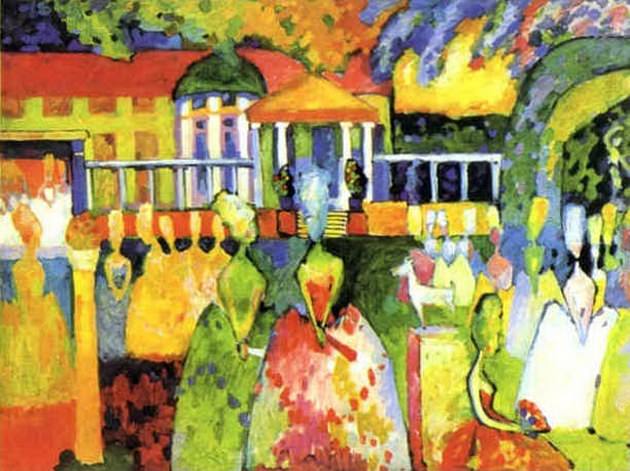Crinolines Vasily Kandinsky (1866-1944)
Vasily Kandinsky – Crinolines
Edit attribution
Download full size: 630×471 px (0,2 Mb)
Painter: Vasily Kandinsky
Between 1900 and 1910 Wassily Kandinsky worked for the magazine World of Art, which published Russian Symbolism. The main subject for the Symbolists’ work at the time, was the culture of the Russian nobility of the 17th century and the first half of the 19th century. It is with this that the retrospective theme of the depiction is connected. "Ladies in Crinolines" is painted in oil on canvas. The picture is flat, fragmentary with the predominance of rhythm and plastics.
Description of Vasily Kandinsky’s painting "Ladies in Crinolines" (1909)
Between 1900 and 1910 Wassily Kandinsky worked for the magazine World of Art, which published Russian Symbolism. The main subject for the Symbolists’ work at the time, was the culture of the Russian nobility of the 17th century and the first half of the 19th century. It is with this that the retrospective theme of the depiction is connected.
"Ladies in Crinolines" is painted in oil on canvas. The picture is flat, fragmentary with the predominance of rhythm and plastics. "Ladies in Crinolines" is the most striking of Kandinsky’s works on the theme of the nobility. The work combines an impressionistic understanding of color as the result of a certain intensity of light. Through this, the master tried to convey to the viewer the spirit of a bygone everyday life. The work is perceived as striving for decorative and monumental generalization, which is characteristic of Art Nouveau. The picture does not have a definite plot, which is characteristic of symbolism. The subjectivity of the work dissolves in the plasticity of painting. Resurrected world of the nobility, painted with lyrical and ironic tone, which can be seen in the "toy" images.
The artist freely plays with color spots, points and lines, as he believed that the colorful consonance of rhythms expresses the inner spiritual content. The color composition presented from yellow to red, reaching a red-orange tone, depicts the maximum brightness of sunlight. By presenting the composition, the artist endows the viewer with an active warm energy. Through the play of colors, the solemn orange tone transitions into a proud hue, giving the appearance of opulence. With its coloring the image is similar to folklore, but at the same time modern, imbued with romanticism.
At the heart of the composition, the artist laid down the rhythm of the arrangement of the figures, not taking into account the subject line. Blurred, indistinct images, appear as memories of noble life.
Кому понравилось
Пожалуйста, подождите
На эту операцию может потребоваться несколько секунд.
Информация появится в новом окне,
если открытие новых окон не запрещено в настройках вашего браузера.
You need to login
Для работы с коллекциями – пожалуйста, войдите в аккаунт (open in new window).

















You cannot comment Why?